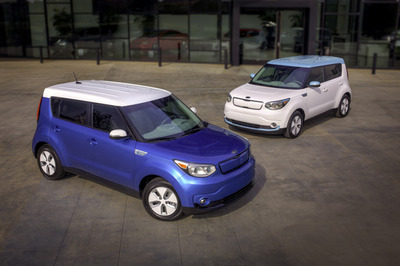Kia Motors America Expands Soul EV Availability to Five Additional States
 |
Hot-Selling Soul Electric Vehicle Will be Available for Sale in Georgia in Q2; Oregon, Washington, Texas and Hawaii Anticipated in June
- Expansion into five new states underlines Kia's commitment to green mobility and its fun and funky alternative fuel vehicle
- Solid infrastructure and consumer demand propel Soul EV beyond California
IRVINE, CA -- March 25, 2015: Following the successful launch of the Soul EV late last year in California, Kia Motors America (KMA) is proud to announce it is expanding availability of its fully charged urban runabout into five new states: Georgia, Texas, Oregon, Washington and Hawaii. Electric vehicle demand has been growing in these states, and consumers there have expressed significant interest in Soul EV. And with more than 1,8001 charging stations combined, the robust EV infrastructure within these markets makes battery-powered travel convenient and an increasingly appealing choice for consumers. Within each state, select Kia retailers will be certified to sell and service the Soul EV, and customers will have access to charging stations installed at these facilities. The Soul EV-authorized Kia dealership locations will be announced closer to the Soul EV's on-sale date in the expansion states later this year. Additional markets are set to come online in 2016.
"From the inception of the Soul EV program, Kia's sales strategy has been progressive and pragmatic," said Orth Hedrick, vice president of product planning, KMA. "With the level of demand and supporting infrastructure in the state, California was a natural place to start, but we've been carefully studying other markets. Between consumer reaction to the Soul EV and growing infrastructure programs in these five states, this is a logical – and exciting – next step in our rollout plan."
Kia has called Georgia home since the late-2006 groundbreaking for the $1-billion Kia Motors Manufacturing Georgia (KMMG) assembly plant in West Point, and it's where the second phase of the Soul EV's expansion will kick off. Sales are set to begin during the second quarter in the "Peach State," and Soul EV owners will easily be able to locate the 2842 charging stations statewide using the standard UVO EV Services3 telematics system. Available at no cost for the first five years of ownership, UVO EV Services utilizes an embedded connectivity solution powered by the Verizon4 network and an integral smartphone app to provide Soul EV owners with an innovative, real-time, in-vehicle connectivity experience that includes navigation and a host of added convenience features.
Following the Soul EV's expansion into Georgia, four other states – Hawaii, Oregon, Washington and Texas – are expected to come online in June, and KMA continues to investigate the possibility of offering the Soul EV in other states as well. Offered in two trims, Base and + (Plus), the 2015 Soul EV MSRP5 is $33,700 (not including federal tax rebate of $7,500) for the Base and $35,700 (not including federal tax rebate of $7,500) for the Plus. A lease price of $249/month for the Soul EV Base6 is also available.
About the 2015 Soul EV
As the centerpiece of the Kia's 'Clean Mobility' efforts, the Soul EV is the embodiment of the brand's environmentally focused mission, transforming the hip urban crossover into Kia's first mass-market, all-electric zero emissions vehicle to be sold in the U.S. Combining the iconic design of the Soul with advanced eco-friendly technology has landed the Soul EV in a class all its own. Honored with an industry-first automotive environmental validation by Underwriters Laboratory (UL)7 for its innovative use of bio-based materials, the Soul EV also has an EPA estimated range rating of 93 miles8 with an MPGe8 of 92 miles highway and 120 miles city for a combined mileage of 105 miles.
The Soul EV makes charging easy by plugging into any standard 120v outlet or a conventional 240v EV charger. Two charging ports are standard, including a SAE J1772 port for Level 1 and Level 2 AC, and a CHAdeMo DC fast-charging port (480v). Found behind a sliding door located in the front grille, the dual ports offer flexibility and increase the Soul EV's go-anywhere appeal, making it more convenient to charge inside the owner's garage or when on the road. Recharging times vary from 24 hours for a fully depleted battery using a standard 120v outlet and under five hours when plugged into a 240v outlet. An 80-percent charge can be achieved from empty in as little as 33 minutes with a 50 kW-output DC fast charger. Kia has partnered with three charger providers – Bosch, LevitonŽ and AeroVironment™ – which give Soul EV buyers an opportunity to select the unit best suited to their in-home needs.
The front-wheel drive Soul EV is powered by a 109-hp (81.4kW) electric motor, producing a generous 210 lb.-ft. of instantaneous torque. The liquid-cooled AC synchronous permanent magnet motor uses multi-layer magnets to help improve efficiency and reduce the whine common to most electric vehicles. The motor delivers its power to the front wheels through a single-speed constant-ratio gear reduction unit. The battery's location beneath the floor results in a lower center of gravity, which helps ride and handling and ensures that the EV remains true to the Soul's fun-to-drive reputation. Additional cross bracing beneath the low-mounted battery contributes to a 5.9 percent improvement in torsional rigidity over the gasoline-powered Soul and offers protection to the battery.
In an effort to maximize efficiency and range, the Soul EV uses Kia's third-generation regenerative braking system to capture up to 12 percent of the car's kinetic energy, which is fed back into the battery while the Soul EV is coasting and braking. Soul EV owners can choose between four drive mode combinations: "Drive" or "Brake" modes in Eco-mode "Off," and "Drive" or "Brake" modes in Eco-mode "On" (the "Brake" or "B" setting with Eco-mode "On" producing the most regeneration).


